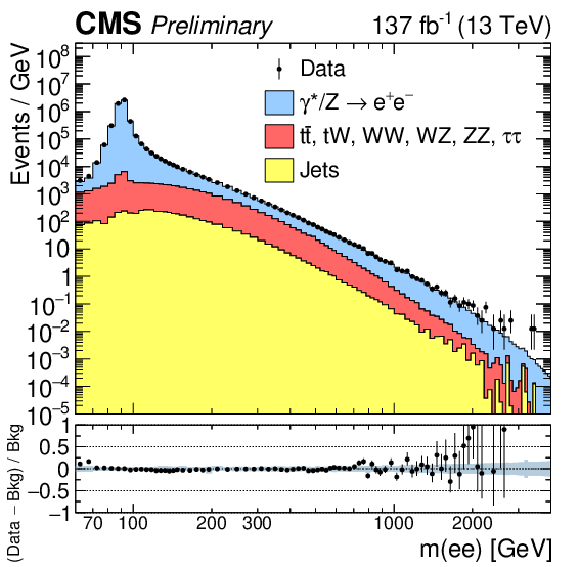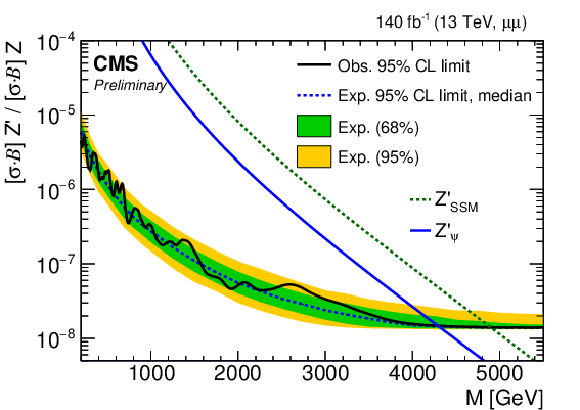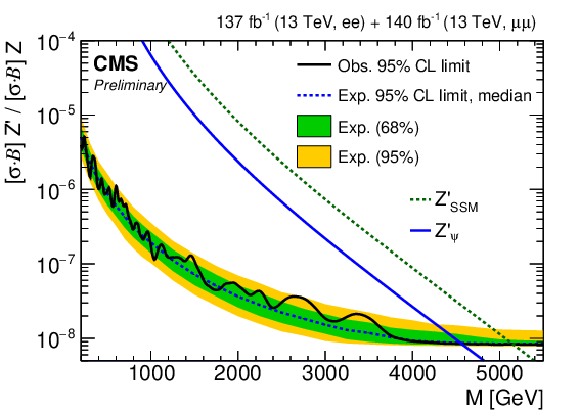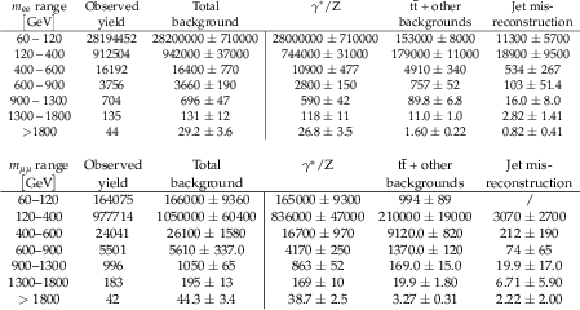

Compact Muon Solenoid
LHC, CERN
| CMS-PAS-EXO-19-019 | ||
| Search for a narrow resonance in high-mass dilepton final states in proton-proton collisions using 140 fb−1 of data at √s= 13 TeV | ||
| CMS Collaboration | ||
| August 2019 | ||
| Abstract: A search for physics beyond the standard model is presented using electron or muon pairs with high invariant mass. A data set of proton-proton collisions collected by the CMS experiment at the LHC at √s= 13 TeV recorded in years 2016 to 2018 and corresponding to a total integrated luminosity of up to 140 fb−1 is analyzed. No significant deviation is observed with respect to the expectation from the standard model backgrounds. Upper limits are set on the ratio of the production cross section times branching ratio of a new narrow dilepton resonance to that of the Z boson and converted into lower limits on the masses of various hypothetical particles. A Z′SSM (Z′ψ) particle, arising in the sequential standard model (superstring-inspired model) is excluded below a mass of 5.15 (4.56) TeV at 95% confidence level. | ||
|
Links:
CDS record (PDF) ;
CADI line (restricted) ;
These preliminary results are superseded in this paper, Accepted by JHEP. The superseded preliminary plots can be found here. |
||
| Figures | |

png pdf |
Figure 1:
The invariant mass distribution of pairs of (left) electrons and (right) muons observed in data (black dots with statistical error bars) and expected from the SM processes (stacked histograms). For the dimuon channel, a prescaled trigger with a pT threshold of 27 GeV was used to collect events in the normalization region (NR) with mμμ< 120 GeV. The corresponding offline threshold is 30 GeV. Events in the signal region (SR) corresponding to masses above 120 GeV are collected using an unprescaled single muon trigger. The bin width gradually increases with mass. The ratio of the data yields after background subtraction to the background yields is shown on the bottom plots. The blue band represents the various statistical and systematic uncertainties on the background. |

png pdf |
Figure 1-a:
The invariant mass distribution of pairs of (left) electrons and (right) muons observed in data (black dots with statistical error bars) and expected from the SM processes (stacked histograms). For the dimuon channel, a prescaled trigger with a pT threshold of 27 GeV was used to collect events in the normalization region (NR) with mμμ< 120 GeV. The corresponding offline threshold is 30 GeV. Events in the signal region (SR) corresponding to masses above 120 GeV are collected using an unprescaled single muon trigger. The bin width gradually increases with mass. The ratio of the data yields after background subtraction to the background yields is shown on the bottom plots. The blue band represents the various statistical and systematic uncertainties on the background. |

png pdf |
Figure 1-b:
The invariant mass distribution of pairs of (left) electrons and (right) muons observed in data (black dots with statistical error bars) and expected from the SM processes (stacked histograms). For the dimuon channel, a prescaled trigger with a pT threshold of 27 GeV was used to collect events in the normalization region (NR) with mμμ< 120 GeV. The corresponding offline threshold is 30 GeV. Events in the signal region (SR) corresponding to masses above 120 GeV are collected using an unprescaled single muon trigger. The bin width gradually increases with mass. The ratio of the data yields after background subtraction to the background yields is shown on the bottom plots. The blue band represents the various statistical and systematic uncertainties on the background. |

png pdf |
Figure 2:
The upper limits at 95% CL on the product of production cross section and branching fraction for a spin-1 resonance with a width equal to 0.6% of the resonance mass, relative to the product of production cross section and branching fraction of a Z boson, for the (top left) dielectron channel, (top right) dimuon channel, and (bottom) their combination. The shaded bands correspond to the 68 and 95% quantiles for the expected limits. Theoretical predictions for the spin-1 Z′SSM and Z′ψ resonances are shown for comparison. |

png pdf |
Figure 2-a:
The upper limits at 95% CL on the product of production cross section and branching fraction for a spin-1 resonance with a width equal to 0.6% of the resonance mass, relative to the product of production cross section and branching fraction of a Z boson, for the (top left) dielectron channel, (top right) dimuon channel, and (bottom) their combination. The shaded bands correspond to the 68 and 95% quantiles for the expected limits. Theoretical predictions for the spin-1 Z′SSM and Z′ψ resonances are shown for comparison. |

png pdf |
Figure 2-b:
The upper limits at 95% CL on the product of production cross section and branching fraction for a spin-1 resonance with a width equal to 0.6% of the resonance mass, relative to the product of production cross section and branching fraction of a Z boson, for the (top left) dielectron channel, (top right) dimuon channel, and (bottom) their combination. The shaded bands correspond to the 68 and 95% quantiles for the expected limits. Theoretical predictions for the spin-1 Z′SSM and Z′ψ resonances are shown for comparison. |

png pdf |
Figure 2-c:
The upper limits at 95% CL on the product of production cross section and branching fraction for a spin-1 resonance with a width equal to 0.6% of the resonance mass, relative to the product of production cross section and branching fraction of a Z boson, for the (top left) dielectron channel, (top right) dimuon channel, and (bottom) their combination. The shaded bands correspond to the 68 and 95% quantiles for the expected limits. Theoretical predictions for the spin-1 Z′SSM and Z′ψ resonances are shown for comparison. |
| Tables | |

png pdf |
Table 1:
Benchmark models considered in this analysis with their corresponding mixing angles; their branching fraction (B) to dileptons; the cu and cd parameter values and their ratio; and the ratio of width to mass of the associated Z' boson. |

png pdf |
Table 2:
Systematic uncertainties considered in this analysis and their magnitude. |

png pdf |
Table 3:
Observed and expected yields for different mass ranges in the (top) dielectron channel and (bottom) dimuon channel. The sum of all background contributions is shown as well as a breakdown into the three main categories. The quoted uncertainty includes both the statistical and the systematic components. |

png pdf |
Table 4:
The observed and expected 95% CL lower limits on the masses of spin-1 Z′SSM and Z′ψ bosons, assuming a signal width of 0.6% (3.0%) of the resonance mass for Z′ψ (Z′SSM). |
| Summary |
| A search for new heavy resonances in the dilepton invariant mass spectrum in proton-proton collisions at √s= 13 TeV corresponding to an integrated luminosity of 140 fb−1 has been presented. High-mass dielectron and dimuon events are reconstructed and selected with algorithms optimized for high-pT electrons and muons. Standard Model backgrounds are primarily estimated from simulation, with the dominant Drell-Yan background corrected to the highest order calculations available, including the contribution from photon induced processes. The background estimate is normalized to the data in a control region around the Z boson peak. No significant deviation from Standard Model expectation is observed. Limits are set on the ratio of the cross section of the new resonance to that of the Standard Model Z boson at 95% CL using Bayesian techniques known to have good frequentist coverage properties. The limits are interpreted in the context of a sequential standard model, and a superstring-inspired one, predicting spin-1 resonances. Lower mass limits of 5.15 TeV (4.56 TeV) are set in the Z′SSM (Z′ψ) models. |
| References | ||||
| 1 | A. Leike | The phenomenology of extra neutral gauge bosons | PR 317 (1999) 143 | hep-ph/9805494 |
| 2 | P. Langacker | The physics of heavy Z' gauge bosons | Rev. Mod. Phys. 81 (2009) 1199 | 0801.1345 |
| 3 | CMS Collaboration | Search for resonances in the dilepton mass distribution in pp collisions at √s= 7 TeV | JHEP 05 (2011) 093 | CMS-EXO-10-013 1103.0981 |
| 4 | CMS Collaboration | Search for narrow resonances in dilepton mass spectra in pp collisions at √s= 7 TeV | PLB 714 (2012) 158 | CMS-EXO-11-019 1206.1849 |
| 5 | CMS Collaboration | Search for heavy narrow dilepton resonances in pp collisions at √s= 7 TeV and √s= 8 TeV | PLB 720 (2013) 63 | CMS-EXO-12-015 1212.6175 |
| 6 | CMS Collaboration | Search for physics beyond the standard model in dilepton mass spectra in proton-proton collisions at √s= 8 TeV | JHEP 04 (2015) 025 | CMS-EXO-12-061 1412.6302 |
| 7 | CMS Collaboration | Search for narrow resonances in dilepton mass spectra in proton-proton collisions at √s= 13 TeV and combination with 8 TeV data | PLB 768 (2017) 57 | CMS-EXO-15-005 1609.05391 |
| 8 | CMS Collaboration | Search for high-mass resonances in dilepton final states in proton-proton collisions at √s= 13 TeV | JHEP 06 (2018) 120 | CMS-EXO-16-047 1803.06292 |
| 9 | ATLAS Collaboration | Search for high mass dilepton resonances in pp collisions at √s= 7 TeV with the ATLAS experiment | PLB 700 (2011) 163 | 1103.6218 |
| 10 | ATLAS Collaboration | Search for high-mass resonances decaying to dilepton final states in pp collisions at √s= 7 TeV with the ATLAS detector | JHEP 11 (2012) 138 | 1209.2535 |
| 11 | ATLAS Collaboration | Search for high-mass dilepton resonances in pp collisions at √s= 8 ~TeV with the ATLAS detector | PRD 90 (2014) 052005 | 1405.4123 |
| 12 | ATLAS Collaboration | Search for new high-mass phenomena in the dilepton final state using 36.1 fb−1 of proton-proton collision data at √s= 13 TeV with the ATLAS detector | JHEP 10 (2017) 182 | 1707.02424 |
| 13 | ATLAS Collaboration | Search for high-mass dilepton resonances using 139 fb−1 of pp collision data collected at √s= 13 TeV with the ATLAS detector | 1903.06248 | |
| 14 | ATLAS Collaboration | Constraints on mediator-based dark matter and scalar dark energy models using √s=13TeVpp collision data collected by the ATLAS detector | JHEP 05 (2019) 142 | 1903.01400 |
| 15 | C. Battilana | The CMS muon system: status and upgrades for LHC Run-2 and performance of muon reconstruction with 13~TeV data | JINST 12 (2017) C01048 | |
| 16 | CMS Collaboration | The CMS experiment at the CERN LHC | JINST 3 (2008) S08004 | CMS-00-001 |
| 17 | CMS Collaboration | The CMS trigger system | JINST 12 (2017) P01020 | CMS-TRG-12-001 1609.02366 |
| 18 | E. Accomando et al. | Z' physics with early LHC data | PRD 83 (2011) 075012 | 1010.6058 |
| 19 | G. Altarelli, B. Mele, and M. Ruiz-Altaba | Searching for new heavy vector bosons in pˉp colliders | Z. Phys. C 45 (1989) 109, . [Erratum: Z. Phys. C 47 (1990) 676] | |
| 20 | J. L. Hewett and T. G. Rizzo | Low-energy phenomenology of superstring-inspired E6 models | PR 183 (1989) 193 | |
| 21 | M. S. Carena, A. Daleo, B. A. Dobrescu, and T. M. P. Tait | Z' gauge bosons at the Tevatron | PRD 70 (2004) 093009 | hep-ph/0408098 |
| 22 | E. Accomando et al. | Z' at the LHC: Interference and Finite Width Effects in Drell-Yan | JHEP 10 (2013) 153 | 1304.6700 |
| 23 | P. Nason | A new method for combining NLO QCD with shower Monte Carlo algorithms | JHEP 11 (2004) 040 | hep-ph/0409146 |
| 24 | S. Frixione, P. Nason, and C. Oleari | Matching NLO QCD computations with parton shower simulations: the POWHEG method | JHEP 11 (2007) 070 | 0709.2092 |
| 25 | S. Alioli, P. Nason, C. Oleari, and E. Re | A general framework for implementing NLO calculations in shower Monte Carlo programs: the POWHEG BOX | JHEP 06 (2010) 043 | 1002.2581 |
| 26 | S. Alioli, P. Nason, C. Oleari, and E. Re | NLO vector-boson production matched with shower in POWHEG | JHEP 07 (2008) 060 | 0805.4802 |
| 27 | S. Frixione, P. Nason, and G. Ridolfi | A positive-weight next-to-leading-order Monte Carlo for heavy flavour hadroproduction | JHEP 09 (2007) 126 | 0707.3088 |
| 28 | E. Re | Single-top Wt-channel production matched with parton showers using the POWHEG method | EPJC 71 (2011) 1547 | 1009.2450 |
| 29 | NNPDF Collaboration | Parton distributions for the LHC Run II | JHEP 04 (2015) 040 | 1410.8849 |
| 30 | NNPDF Collaboration | Parton distributions from high-precision collider data | EPJC 77 (2017) 663 | 1706.00428 |
| 31 | T. Sjostrand et al. | An Introduction to PYTHIA 8.2 | CPC 191 (2015) 159 | 1410.3012 |
| 32 | CMS Collaboration | Event generator tunes obtained from underlying event and multiparton scattering measurements | EPJC 76 (2016) 155 | CMS-GEN-14-001 1512.00815 |
| 33 | CMS Collaboration | Extraction and validation of a new set of CMS PYTHIA8 tunes from underlying-event measurements | CMS-GEN-17-001 1903.12179 |
|
| 34 | Y. Li and F. Petriello | Combining QCD and electroweak corrections to dilepton production in FEWZ | PRD 86 (2012) 094034 | 1208.5967 |
| 35 | A. Manohar, P. Nason, G. P. Salam, and G. Zanderighi | How bright is the proton? A precise determination of the photon parton distribution function | PRL 117 (2016) 242002 | 1607.04266 |
| 36 | J. Butterworth et al. | PDF4LHC recommendations for LHC Run II | JPG 43 (2016) 023001 | 1510.03865 |
| 37 | D. Bourilkov | Photon-induced background for dilepton searches and measurements in pp collisions at 13 TeV | 1606.00523 | |
| 38 | D. Bourilkov | Exploring the LHC Landscape with dileptons | 1609.08994 | |
| 39 | M. Czakon and A. Mitov | Top++: a program for the calculation of the top-pair cross-section at hadron colliders | CPC 185 (2014) 2930 | 1112.5675 |
| 40 | N. Kidonakis | Two-loop soft anomalous dimensions for single top quark associated production with a W− or H− | PRD 82 (2010) 054018 | 1005.4451 |
| 41 | J. Alwall et al. | The automated computation of tree-level and next-to-leading order differential cross sections and their matching to parton shower simulations | JHEP 07 (2014) 079 | 1405.0301 |
| 42 | R. Boughezal et al. | Color-singlet production at NNLO in MCFM | EPJC 77 (2016) 7 | 1605.08011 |
| 43 | J. M. Campbell, R. K. Ellis, and W. T. Giele | A multi-threaded version of MCFM | EPJC 75 (2015) 246 | 1503.06182 |
| 44 | J. M. Campbell, R. K. Ellis, and C. Williams | Vector boson pair production at the LHC | JHEP 07 (2011) 018 | 1105.0020 |
| 45 | J. M. Campbell and R. K. Ellis | Update on vector boson pair production at hadron colliders | PRD 60 (1999) 113006 | hep-ph/9905386 |
| 46 | M. R. Whalley, D. Bourilkov, and R. C. Group | The Les Houches accord PDFs (LHAPDF) and LHAGLUE | in HERA and the LHC: A Workshop on the implications of HERA for LHC physics. Proceedings, Part B 2005 | hep-ph/0508110 |
| 47 | D. Bourilkov, R. C. Group, and M. R. Whalley | LHAPDF: PDF use from the Tevatron to the LHC | in TeV4LHC Workshop - 4th meeting Batavia, Illinois, October 20-22, 2005 (2006) | hep-ph/0605240 |
| 48 | A. Buckley et al. | LHAPDF6: parton density access in the LHC precision era | EPJC 75 (2015) 132 | 1412.7420 |
| 49 | GEANT4 Collaboration | GEANT4--a simulation toolkit | NIMA 506 (2003) 250 | |
| 50 | CMS Collaboration | Performance of CMS muon reconstruction in pp collision events at √s= 7 TeV | JINST 7 (2012) P10002 | CMS-MUO-10-004 1206.4071 |
| 51 | CMS Collaboration | Performance of electron reconstruction and selection with the CMS detector in proton-proton collisions at √s= 8 TeV | JINST 10 (2015) P06005 | CMS-EGM-13-001 1502.02701 |
| 52 | Particle Data Group, M. Tanabashi et al. | Review of particle physics | PRD 98 (2018) 030001 | |
| 53 | ATLAS and CMS Collaborations | Procedure for the LHC Higgs boson search combination in Summer 2011 | CMS-NOTE-2011-005 | |
| 54 | L. Moneta et al. | The RooStats Project | in 13th International Workshop on Advanced Computing and Analysis Techniques in Physics Research (ACAT2010) SISSA, 2010 PoS(ACAT2010)057 | 1009.1003 |
| 55 | M. J. Oreglia | A study of the reactions ψ′→γγψ | PhD thesis, Stanford University, 1980 SLAC Report SLAC-R-236, see A | |

|
Compact Muon Solenoid LHC, CERN |

|

|

|

|

|

|